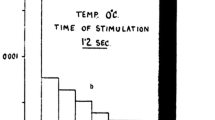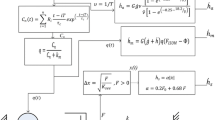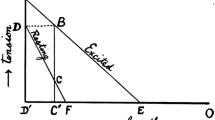Abstract
The power output of rabbit latissimus dorsi muscle was calculated under isotonic conditions and during oscillatory work. Isotonic shortening studies yielded a maximum power output of 120 W·kg−1 at a P/P 0 of 0.4 compared to a maximum power output of 32 W·kg−1 obtained using the work loop technique. This difference can largely be explained by comparing actual work loops with those constructed using force velocity (P/V) and isometric data. At low cycle frequencies, work loop power output is quite close to that predicted from P/V and isometric data. However, at higher frequencies other dynamic muscle properties appear to exert a more marked effect.
Similar content being viewed by others
References
Altringham JD, Johnston IA (1988) The mechanical properties of polyneuronally innervated, myotomal muscle fibres isolated from a teleost fish (Myoxocephalus scorpius). Pflügers Arch 412:524–529
Altringham JD, Johnston IA (1990) Modelling muscle power output in a swimming fish. J Exp Biol 148:395–402
Altringham JD, Johnston IA (1990) Scaling effects on muscle function: power output of isolated fish muscle fibres performing oscillatory work. J Exp Biol 151:453–467
Altringham JD, Young IS (1991) Power output and frequency of oscillatory work in mammalian diaphragm muscle: the effects of animal size. J Exp Biol 157:381–389
Altringham JD, Wardle CS, Smith CI (1993) Myotomal muscle function at different locations in the body of a swimming fish. J Exp Biol 182:191–206
Colomo F, Lombardi V, Piazzesi G (1986) A velocity-dependent shortening depression in the development of the force-velocity relation in frog muscle fibres. J Physiol (Lond) 380:227–238
Curtin NA, Woledge RC (1991) Efficiency of energy conversion during shortening of muscle fibres from the dogfish Scyliorhinus canicula: J Exp Biol 158:343–353
Edman KAP (1980) Depression of mechanical performance by active shortening during twitch and tetanus of vertebrate muscle fibres. Acta Physiol Scand 109:15–26
Edman KAP, Mulieri LA, Scubon-Mulieri B (1976) Non-hyperbolic force-velocity relationship in single muscle fibres. Acta Physiol Scand 98:143–156
Edman KAP, Elzinga G, Noble MIM (1978) Enhancement of mechanical performance by stretch during tetanic contractions of vertebrate skeletal muscle fibres. J Physiol (Lond) 281:139–155
Edman KAP, Elzinga G, Noble MIM (1982) Residual force enhancement after stretch of contracting frog single muscle fibres. J Gen Physiol 80:769–784
Ekelund MC, Edman KAP (1982) Shortening deactivation of skinned fibres of frog and mouse striated muscle. Acta Physiol Scand 116:189–199
Gillott KL, Cox VM, Wright H, Eaves LA, Williams PE, Goldspink DF (1994) The fibre type composition of the rabbit latissimus dorsi muscle. J Anat 185:173–179
Hill AV (1970) First and last experiments in muscle mechanics. Cambridge University Press, London
James RS, Altringham JD, Goldspink DF (1995) The mechanical properties of fast and slow skeletal muscles of the mouse in relation to their locomotory function. J Exp Biol 198:491–502
Johnston IA, Altringham JD (1985) Evolutionary adaptation of muscle power output to environmental temperature: force-velocity characteristics of skinned fibres isolated from Antarctic, temperate and tropical marine fish. Pflügers Arch 405:136–140
Johnson TP, Johnston IA (1991) Power output of fish muscle fibres performing oscillatory work: effects of acute and seasonal temperature change. J Exp Biol 157:409–423
Josephson RK (1985) Mechanical power output from striated muscle during cyclic contraction. J Exp Biol 114:491–512
Josephson RK (1989) Power output from skeletal muscle during linear and sinusoidal shortening. J Exp Biol 147:533–537
Josephson RK (1993) Contraction dynamics and power output of skeletal muscle. Annu Rev Physiol 55:527–546
Kilarski W, Sjöström M (1990) Systematic distribution of muscle fibre types in the rat and rabbit diaphragm: a morphometric and ultrastructural analysis. J Anat 168:13–30
Kushmerick MJ, Davies RE (1969) The chemical energetics of muscle contraction. II. The chemistry, efficiency and power of maximally working sartorius muscle. Proc R Soc Lond [Biol] 174:315–353
Marsh RL, Bennett AF (1986) Thermal dependence of contractile properties of skeletal muscle from the lizard Sceloporus occidentalis with comments on methods for fitting and comparing force velocity curves. J Exp Biol 126:63–77
Olson JM, Marsh RL (1993) Contractile properties of the striated adductor muscle in the bay scallop Argopectans irradians at several temperatures. J Exp Biol 176:175–193
Rome LC, Sosnicki AA (1990) The influence of temperature on mechanics of red muscle in carp. J Physiol (Lond) 427:151–169
Rome LC, Swank D (1992) The influence of temperature on power output of scup red muscle during cyclical length changes. J Exp Biol 171:261–281
Segal SS, Faulkner JA (1985) Temperature-dependent physiological stability of rat skeletal muscle in vitro. Am J Physiol 248:265–270
Stevens ED (1993) Relation between work and power calculated from force-velocity curves to that done during oscillatory work. J Muscle Res Cell Motil 14:518–526
Syme D (1990) Passive viscoelastic work of isolated rat, Rattus norvegicus diaphragm muscle. J Physiol (Lond) 424:301–315
Woledge RC, Curtin NA, Homsher E (1985) Energetic Aspects of Muscle Contraction. Academic, London
Author information
Authors and Affiliations
Rights and permissions
About this article
Cite this article
James, R.S., Young, I.S., Cox, V.M. et al. Isometric and isotonic muscle properties as determinants of work loop power output. Pflügers Arch. 432, 767–774 (1996). https://doi.org/10.1007/s004240050197
Received:
Accepted:
Issue Date:
DOI: https://doi.org/10.1007/s004240050197




